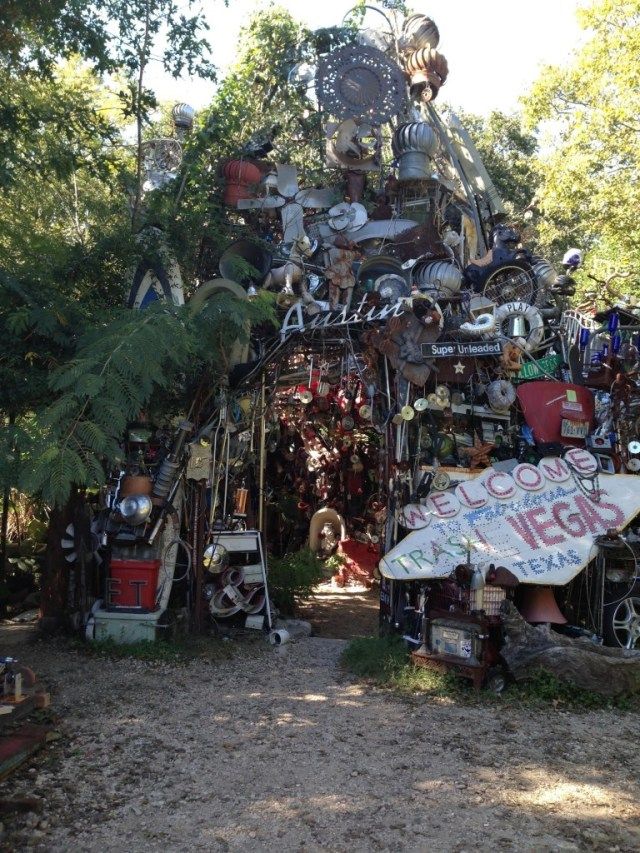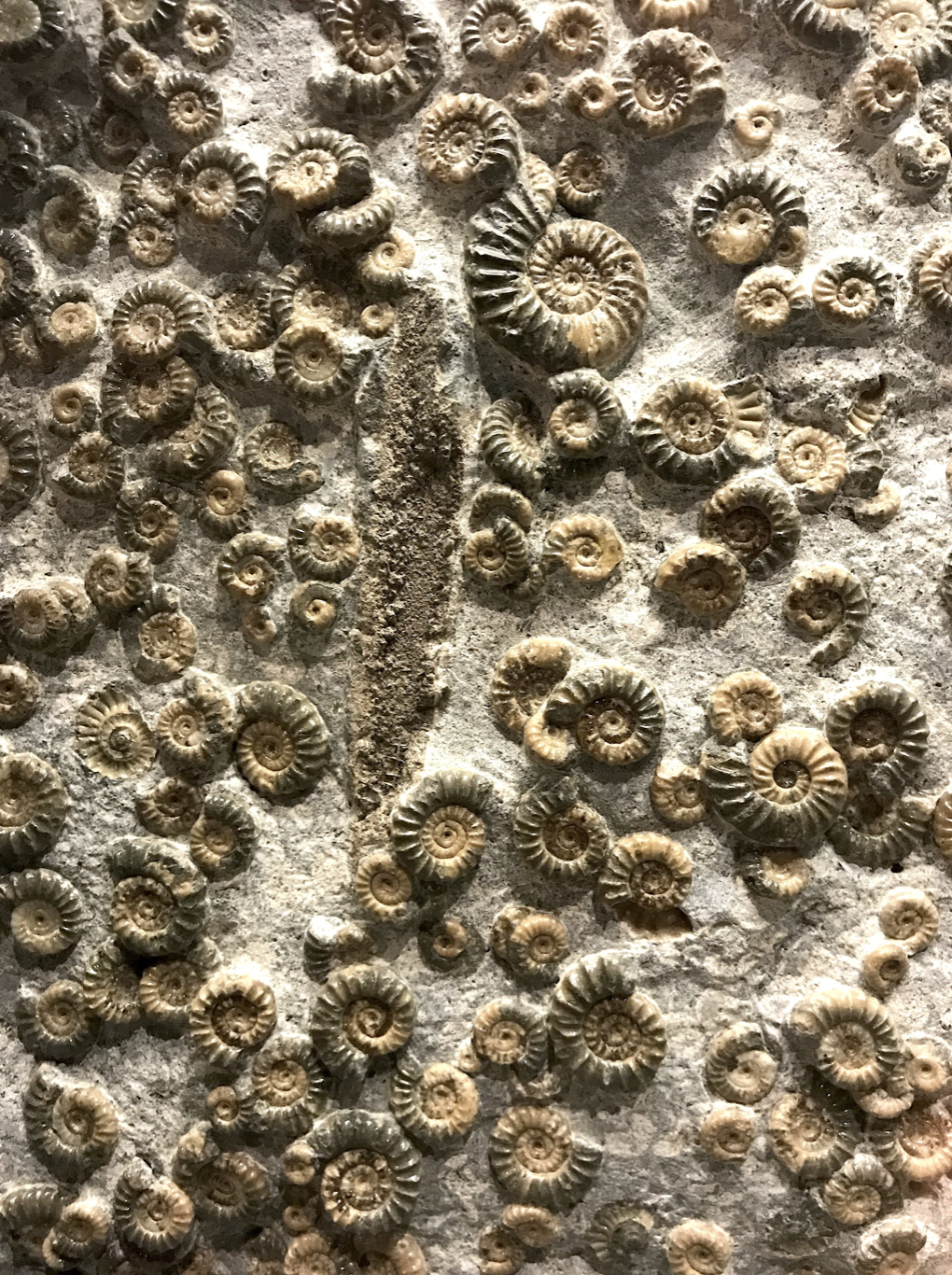We parked across the street from 4422 Lareina Drive, wondering what we were getting ourselves into.
“I think I see something,” I announced to my friends, craning my neck to see the enormous sculpture behind the house. A canopy of trees and a privacy fence made seeing the Cathedral of Junk from the street almost impossible. Good thing we had an appointment.
As we approached the house, the “Do not knock, baby sleeping” sign forced us around to the side where we entered the backyard through a chain-link fence. The owner Vince Hannemann, a small, unassuming man, met us at the gate along with his dog, a part-Australian shepherd named Smoky. My friend slid a $10 bill into Vince’s hand while I reached down to scratch Smoky’s ears. The smell of a campfire hung low in the cool Austin air. It was November, but unseasonably cold.

After a few simple instructions (“Feel free to climb on it,” “there are stairs in the back,” “take your time”), we walked past the wooden welcome shack, past the warmth of the slow-burning campfire we had smelled earlier, straight into the belly of the Cathedral of Junk, rising three stories from the grass-bare lawn.
The structure, which Hannemann began working on back in 1989 when he did seasonal construction work as his full-time job, was too much to take in all at once. Everywhere, recognizable bits of plastic, metal, rubber, and stone were pieced together with wire and rebar and concrete. A “Welcome to Fabulous *Trash* Vegas, Texas” sign welcomed us as we entered, along with a stone cherub face, a plastic rocking horse, a tin woman, and a knight’s mask and shield.

Though the structure was made entirely of garbage, the carefully assembled cathedral boasted rooms and sitting nooks, staircases and balconies, play areas and patios. As we explored each section, we began to see that this was not a trash heap, nor was it just thrown together. Rather, the refuse of decades was carefully collected, arranged, and repurposed into something new. The Cathedral of Junk felt like a shrine to ephemera, the excesses of our throwaway culture staring us right in the face.
“The very notion of ephemera is curious: objects of little value that weren’t meant to be preserved but whose vulnerability, I imagine, appealed to someone,” writes Nicole Rudick, in her Paris Review “Paper Trail.” “Political buttons, business cards, seed packets, and train timetables—scrappy artifacts that otherwise would have been lost to the dustheap.”
While the materials comprising the cathedral are not technically ephemera—the hubcaps and ceramic tiles and metal box springs were created to last a few years, at least—nothing is safe from our changing whims and evolving tastes these days. Since everything is disposable now, everything has become curiously collectible. The difference: stamps and theater tickets and grammar school report cards would eventually—even quickly—disintegrate and disappear if not collected and protected. But the old bicycle tires and rotary telephones and glass bricks so popular in the last century are strangely enduring.
This slideshow requires JavaScript.
That was the eeriest part of my tour of the cathedral. Not only had the legions of junk been collected and preserved, but the structure they created was solid and sturdy. I expect with just a little effort, it will be around for my grandchildren and their grandchildren, if they made the trip to Austin.
Hannemann didn’t start out to make a lasting structure in honor of the passing whims of his culture. In fact, he just started by hanging hubcaps along the fence in his backyard. As he had time, he expanded his creation, watching his art grow in the privacy of his own backyard. Eventually, though, when his home became a stop for tour buses and neighbors started to complain, the city got involved. Hannemann and a cadre of volunteers removed four tons of the recyclable junk. Several sections of the sculpture had to be dismantled and reassembled. Restrictions were added: the structure cannot exceed 32 feet in height, and it must remain at least five feet away from the fence. He hired two different engineers to sign off on the safety of the structure.
“And they told me, ‘no more articles in the Wall Street Journal,’” Hanneman recounted during our visit.
He continues to add to the Cathedral of Junk; it’s his full-time job now. He charges $10 per group to visit the cathedral, and people bring or send him junk to add to the collection. And though the structure currently boasts a small slide for children made out of tile, he has plans to build a larger slide for adults.
“Will you have to have the structure re-inspected when you add to it?” I asked.
“The city of Austin has never said that to me,” Hanneman replied. “My attorney said ‘go for it.’”
It seems haphazard, but he has a plan.

I think of Hanneman’s cathedral now and then as I cart home new clothes and kitchen utensils and books and furniture. We try to buy only what we need and will use, but still, we always seem to be finding a place for or putting away our stuff.
“Goods and chattels seek a man out; they find him even though his guard is up,” writes author E.B. White in “Good-bye to Forty-eighth Street.” He was reflecting on the ephemera and excesses of his own life as he prepared to move from his New York City apartment:
“Books and oddities arrive in the mail. Gifts arrive on anniversaries and fete days. Veterans send ballpoint pens. Banks send memo books. If you happen to be a writer, readers send whatever may be cluttering up their own lives; I had a man once send me a chip of wood that showed the marks of beaver’s teeth. Someone dies, and a little trickle of indestructible keepsakes appears, to swell the flood.”
To be fair, we try to get rid of things, too. Our basement serves as a staging area to organize the outgoing stuff: a box for donations, a bin for recyclables. While even this small rotation of our ephemera could produce its own monument to junk, the real problem for us, and for White, is that what comes in is not balanced by what goes out.
“Under ordinary circumstances, the only stuff that leaves a home is paper trash and garbage; everything else stays on and digs in,” White writes.
The result? If we are not careful, the Cathedral of Junk is not just a nice place to visit. It becomes our home, three stories of junk carefully and elaborately assembled within wood and metal and stone.
I don’t know which is worse: buying and discarding an excess of stuff, or buying and keeping the excess. The simple answer, it seems, is just to avoid the excess. And maybe that’s one lesson Hanneman is trying to teach us all. But walking in and among the beauty created from rubbish, I don’t think that’s the only lesson.
I think the unassuming man in Austin would be more likely to caution us to be careful what we build in the first place, because in the end, those things last longer and draw a bigger audience than we would ever expect.




